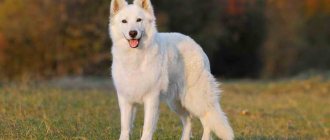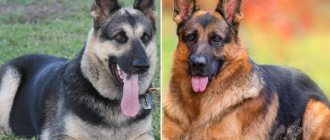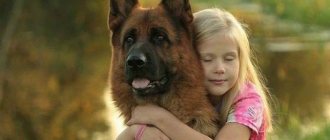History of the origin of the East European Shepherd
East European Shepherd
The ancestors from which East European Shepherds (VEO) originate are German shepherds that appeared in Europe. The Germans are famous all over the world. In 1907 (during the Russo-Japanese War), German shepherds were brought to Russia to serve on military installations. During the period of hostilities, the dogs established themselves as orderlies and bloodhounds, after which the shepherd dogs were sent to serve in the police. Active work to improve the existing breed began in 1940.
The East European Shepherd was bred in northern Russia. Some sources suggest that the genes of Siberian huskies were involved in the selection. Harsh climate conditions played a big role in the creation of the new species. The VEO dog is a large, tall animal. The body is stretched and the skeleton is strong.
Note! Some associate the name of the breed with the name of the East European Plain, but this territory on the map has absolutely nothing to do with the dog.
The VEO dog breed has other names:
- European Shepherd;
- Eastern Shepherd;
- Far Eastern Shepherd;
- Central European;
Development history in numbers:
- 1922-1940 – breeding the breed and developing positive qualities, the “Red Star” nursery was created, which oversaw the work of breeding the breed;
- 1941-1945 – active use of the breed in military campaigns;
- 1964 – 1990 – the Eastern European breed is officially registered, standards are fixed;
- 1991-2002 – The German Shepherd is officially recognized internationally, but the VEO remains an illegal breed.
Character and appearance
Shepherd dogs of Eastern European origin have the following characteristics:
- curiosity;
- developed intelligence;
- friendliness to children and animals;
- restraint;
- courage;
- devotion.
This breed is ideal for guarding a home or territory and will not cause inconvenience to family members.
These dogs are quite large and proportionally built. Despite their advantage in strength, they do not offend the weak: children, animals. Shepherd dogs are active, hardy, curious and take part in family leisure time.
Advantages and disadvantages of the breed
The VEO Shepherd is used not only for business purposes, but also as a pet.
| Pros of the breed | Cons of the breed |
| Loyalty and commitment to the owner | Not suitable for beginners |
| High life expectancy | Expensive maintenance (food, care at the veterinary clinic) |
| Rapid adaptation to the environment | Stubbornness |
| Good protective qualities at the genetic level | Manifestation of negative character traits due to improper training |
| High level of learning ability | |
| Loves children | |
| Distrust of strangers |
The advantages of the breed outnumber the disadvantages.
Difference between German and East European Shepherd
VEO are recognized as a separate breed only in the CIS. The Fédération Cynologique Internationale defines them as a variety of the German dog.
However, Eastern Shepherds have many distinct individual traits:
- larger size and taller;
- smaller angle of inclination in the back;
- wider chest;
- predominantly light tone in color.
- VEO is more suitable for office tasks. "Germans" make good pets.
These breeds look similar, but are very different in character. “Germans” are more active and mobile. They are welcoming and friendly towards others. Eastern Shepherds are reserved and wary.
Comparison with the German Shepherd
Comparative characteristics of breeds:
| Comparison criterion | German Shepherd | East European Shepherd |
| Source of origin | Obtained as a result of selection | Obtained as a result of selection |
| Appearance | The ridge line descends at an angle of 23 degrees to the tail, the body of the German varies between 61-77 cm, the hind legs are carried further than the ridge | There is no slope of the ridge, the body is much larger, the hind legs are almost level with the ridge |
| Temperament | Increased energy and sociability | Calmness and distrust of people |
| Training | Easy to train and educate | Easy to train and educate |
| Height at withers Weight Ridge/back Purpose Color | Up to 65 cm Up to 40 kg Inclined Search work, sports competitions, work in pastures, watchman Black, black, zoned | Up to 76 cm Up to 60 kg Rovnaya Security, guide Black, black, zoned |
Comparison of German and East European Shepherds
Thus, the breeds have both differences and similar qualities:
- loyalty and love to the owner;
- developed intellectual abilities;
- color variety of appearance.
East European Shepherd \»VEO-Working Dog\»
USE OF THE EASTERN EUROPEAN SHEPHERD DOG. (again from my old site) When breeding the East European Shepherd, the functionality of all components of this breed was put at the forefront. This dog was bred to serve throughout the entire territory of our vast homeland. This required a dog that could perform various services: guard, patrol, search, mine investigation, sanitary and sabotage. For example, the most common color of the East European Shepherd - black and gray tan - perfectly camouflaged the dog among snow and trees, various buildings and paths. The close-fitting coat with a thick undercoat protected the dog from both heat and cold, and from moisture. Breeders struggled with the long-haired defect, because... In wet weather, the long coat would get wet through and through and the dog would freeze, get sick, and in the worst case, die. Such individuals were not suitable for work and were discarded. East European Shepherds are widely used in the service of humans, like no other breed of dog. They are successfully used in the Russian armed forces, in the border troops as guard, protective, search and guard; in the Ministry of Internal Affairs as patrol and escort. The East European Shepherd is successfully used as a guide for the blind, as well as in the search and rescue service of the Ministry of Emergency Situations. Rescuers - “East European Shepherds” without looking back go to the most dangerous areas, to where people need their help. Vostochniki have found application in geological exploration, showing good results in the search for ore. Also, the East European Shepherd has found its use in sports. Sport with an Easterner is not just training a dog, it’s more about communicating with a partner with whom you can do everything - agility, all-around, skijoring (dog racing), and the most difficult “Big Ring”. At competitions in the General Training Course and the Protective Guard Service, VEO often took leading places. What other breed can boast such a wide range of uses? The dedication of these dogs is legendary. This is probably why feature films in which these wonderful dogs become the heroes are so popular and beloved (“Give me a paw, Friend”, “Come to me, Mukhtar”, “Border Dog Scarlet”, “Faithful Ruslan”, etc.)
East European Shepherd (EVO) puppies are some of the smartest and cutest dogs. The dog is a real treasure for a person: smart, quick-witted, independent and loyal. Cheerful and good-natured, an ideal guard, watchman and bodyguard.
Possession of unique service qualities obliges the owner not only to carefully care for and maintain the animal, but also to regularly work with it. It is especially important to take primary socialization lessons with your baby and not miss the age at which they start learning.
Today we will talk about the magnificent shepherd VEO, how to raise, choose a baby and provide him with a high-quality and long life with a person.
Breed standard
Description of the East European Shepherd breed according to the standard:
| Options | Male | Girl |
| Height at withers, cm | 66-76 | 62-72 |
| Weight, kg | 35-60 | 30-50 |
The muzzle of the VEO dog breed is designed in the form of a blunt cone, narrowing towards the large nose. The forehead is flat and wide. The bump on the back of the head is weakly defined, as are the brow ridges. The lips are painted black. The jaw bones are powerful and developed. The tongue is long. The color is pale pink or dark pink.
The shape of the ears is close to an isosceles triangle, with slightly rounded tops. They are in a standing position. During the period of excitement of the dog, the ears are positioned clearly parallel to each other; other options are considered a deviation from the norm.
The neck is muscular but dry. Widens as it approaches the back. The body is elongated, it is greater than the height at the withers by an average of 17%. The chest touches the elbows, which serves as proof of its depth. The back is long, the belly is not dry. The tail is shaped like a saber. While working, the dog does not touch his back with his tail, only keeps it at its level.
Dog that meets the breed standard
Color and coat type
Color is available in several shades:
- black-and-white - let's say a darkened area on the back, going down to the paws and sides, as well as a mask;
- zonal – the color range is wide, let’s say red and gray, hair color – ring;
- black – the coat is completely black, a rare color.
Standard color of the East European Shepherd
Please note! Red and gray colors are not recommended, but there is no official ban on them. White shade is allowed.
The length of the coat depends on the purity of the genes. According to the standard, the coat should be of medium length, hard, dense and dense, lying close to the body. The undercoat is soft compared to the coat and slightly lighter than the main color. In practice, there are both long-haired and short-haired dogs.
Characteristics and standards
Visual characteristics of the breed according to the standard:
- height of males - 66-76 cm at the withers. The norm for bitches is 62-72 cm;
- body length is 10-15% longer than the first indicator;
- the head is proportional, length – 40% of the height at the withers, wide;
- the coat is hard, thick, straight;
- the color is zoned, black-backed, with a light background;
- the muzzle is wedge-shaped, with a developed lower jaw;
- nose large, black;
- ears are medium-sized, triangular, pointed, erect;
- neck with developed muscles, located at an angle of 45 degrees;
- the back is wide, strong;
- tucked belly.
Dog Character Traits:
- equilibrium;
- confident behavior;
- suspicious attitude towards strangers;
- activity;
- good defensive reaction;
- attentiveness;
- ability to learn.
This standard is approved by the Russian Cynological Federation (RKF). The document specifies the deviations allowed for the breed.
A separate section describes disqualifying defects - if a dog has them, then it does not meet the standard and cannot participate in competitions or be used for purebred breeding.
Intelligence and character of the East European Shepherd according to the standard
The Oriental dog is smart and quick-witted. She quickly remembers commands and easily follows the owner's instructions.
Attitude towards the owner
Pets are devoted servants of their owner. After completing the training course, they follow all commands. The European acts as a psychologist for the owner, understands everything and has calmness. For people with visual impairments it can serve as a faithful guide and guide.
Dogs' attitude towards strangers
Due to their calmness, dogs act based on the prevailing circumstances. A well-trained dog does not show aggression towards strangers without reason, but is wary and does not trust. The dog is able to stand up for the possessions entrusted to it and prevent encroachment from a stranger.
Attitude towards children and pets
The Shepherd is a large pet, but despite its impressive size it will not cause any inconvenience or harm. The dog can sometimes look stern, but it is ready to protect and play with children. For a dog, the owner's children are considered the main object of protection. The rest of the pets living in the same territory with individuals of the European breed do not experience discomfort, since the dogs are tolerant of other animals. When danger arises, they also protect and protect pets.
Security qualities
The main difference between VEO and other breeds is that they fight not for their own lives, but for the lives of the owner and his loved ones. At any time of the day, the shepherd is ready to work. A fighting spirit arises immediately when an emergency situation arises. Characteristic features are devotion and lack of fear if the owner is in trouble. The dog's owner's life is more valuable than his own.
Training and education
A serious service dog requires serious training. The East European Shepherd is one of these breeds. From the first day, as soon as you bring a little puppy into your home, you need to educate him. The pet must learn the rules of behavior in the house, in the yard, and in public places. Also at an early age, socialization is carried out, introducing the young dog to the outside world.
VEO is very smart and quick-witted, the main thing is to establish a trusting relationship with her pupil. The first commands that you need to teach a puppy are the simplest: place, sit, no, come to me, etc. Then the shepherd must undergo a serious training course, preferably under the guidance of an experienced dog handler. If you plan to make VEO a service dog, guard dog, or guide dog for a blind person, you will need an additional, special course in the chosen area.
The shepherd quickly remembers commands and tries to carry them out conscientiously. Serious training of such a dog should begin from the age of six months. The owner must achieve complete obedience from the pet during training. At the same time, physical punishment is unacceptable, only consistency, calm and perseverance. For success, be sure to reward your dog with treats, kind words, and petting. It is worth noting that VEOs are not afraid of heights, attacks of the person involved, walking on the boom is not a problem for them.
Interesting Facts
- East European Shepherds often become movie actors.
- A beautiful sculpture of a border guard with a shepherd dog of the specified species was created in Moscow. Local residents have come up with a belief that if you just rub the nose or paw of a shepherd dog, after such a ritual life will only follow a white streak.
- The VEO breed is recognized as one of the patriotic breeds.
Key points in training
Training Shepherds
Pets are easy to educate and train; obedience and unquestioning execution of commands are in their blood. The dog is always one step lower than the owner, since the owner is the main one in the human-dog relationship. The pet does not want to show its owner that it is smarter.
During training, the shepherd loves praise and treats as a reward. Training begins at 2 months. The key to successful parenting is consistency in activities with your pet.
At 2 months, the puppy must follow basic commands:
- "To me";
- “Ugh” or “No”;
- "Place";
- "Give me your voice."
The dog masters more complex commands in the age range from 4 to 6 months. Daily walks should be accompanied by sports exercises to overcome obstacles. Classes can also be conducted on special platforms for dogs. In the age range from 4 to 6 months, the puppy masters more complex commands:
- "Sit";
- "Lie"
- "Near";
- "Stand";
- "Give";
- "Forward".
By the 8th month of life, a new skill is revealed - to find objects. Similar classes are carried out by dog handlers. At 1 year and 6 months, the puppy should have developed all the basic skills. If the dog has easily mastered the initial course, then further training will proceed without difficulties.
Note! Consistent training with a puppy develops discipline and transforms behavior from thoughtless to productive.
Nutrition
The East European Shepherd is unpretentious in terms of food. These dogs can maintain stamina even with poor nutrition, but it must be complete to maintain important functions.
Most of the foods allowed for feeding are present in the standard human diet.
Sources of carbohydrates for dogs:
- cereals (buckwheat, pearl barley, oatmeal, rice);
- sugar-free bakery products;
- vegetables;
- fruits.
To maintain physical fitness, shepherd dogs require protein:
- meat;
- offal (lungs, kidneys, liver, hearts);
- fish;
- cottage cheese;
- kefir;
- yogurt.
To avoid intestinal volvulus, you should feed the Oriental Shepherd Dog in small portions, but more often.
At 1 month, the puppy should eat 4-5 times a day. Feeding frequency: every 4 hours. Portion weight – 200 g. Products include beef, cottage cheese, milk, kefir, chicken eggs, buckwheat. It is acceptable to give an omelet.
By three months, increase the portion to 300 g. Half of the diet should be dairy products, a quarter should be meat, the rest should be vegetables, cereals, and soups.
At 4 months, the number of feedings is reduced to three per day. The weight of each serving is 300 g. The ratio of products is the same. At 5-6 months, 400-500 g of food are consumed per meal. By the year the serving size doubles.
Important features of care and nutrition
The health of a shepherd depends on the characteristics of the conditions of detention. Consistent walking and feeding will only benefit the dog. The East European Shepherd is capable of living both in an apartment and in the courtyard of a private house.
Feeding rules
The diet may include ready-made food or home-made food. The composition of the diet is selected based on the age, as well as the position of the female (pregnancy or lactation). The puppy is fed 6 times a day.
The diet should consist of:
- lean meats;
- croup;
- vegetables;
- water;
- if necessary, fermented milk products.
Depending on the time of year, ready-made vitamin supplements are included in the diet. Feeding is carried out after a walk.
Feeding the dog
Care and hygiene
Caring for an Eastern European pet is standard:
- bathing once a year;
- brushing the coat once a week;
- during the molting period, the fur should be combed every other day;
- ears, as well as eyes, must be cleansed once every 7 days;
- Teeth should be cleaned using bones.
Timely vaccination will help improve your health. The first vaccination is carried out at 8 weeks. Revaccination is carried out 30 days after vaccination. Treatment against helminths, ticks and fleas is carried out once every three months; in addition, you can use a special collar that protects against parasites. Wearing a collar does not exclude a preventive examination for the presence of ticks.
Walking and physical activity
Walks are carried out 2 times a day. Purpose of the walk:
- fulfillment of natural needs;
- maintaining physical development;
- communication with the owner.
If a dog lives in the yard and does not need walks, then it still needs exercise and sports training.
Note! Activities such as playing with a plate or stick, or overcoming barriers support and develop the dog's muscles.
Health
With proper care and proper nutrition, an East European Shepherd can live 12-14 years. Representatives of the breed are distinguished by good health and strong immunity, but there is a predisposition to certain diseases:
- Conjunctivitis is a fairly common inflammation of the connective membrane of the eye in dogs. It is difficult to treat, which often leads to a complicated chronic form.
- Hip dysplasia – problems with the joints cause severe pain, and if left untreated, the dog can become immobile.
- Obesity is a serious illness in the modern world, so if your dog is fat, then you should resort to changing your diet and proper diet.
- Arthritis - inflammation of the joints causes severe pain to the animal. This disease is more common in older animals.
- Eczema is one of the most common skin diseases. Because of the coat, especially if the coat is thick, eczema in dogs goes unnoticed for a long time. The owner must be attentive so that the disease is noticed and stopped in time.
It is important to carry out routine vaccinations in a timely manner. In order to detect the disease in time at the initial stage, it is recommended to undergo preventive examinations at a veterinary clinic several times a year, including tests and x-rays. Skin parasites require treatment. It is also necessary to give your pet medications for internal parasites.
How to choose a good VEO puppy
The physical characteristics of puppies depend on heredity, the number of puppies in one litter, as well as on the environmental conditions in which they were born. As a rule, males are smaller than females at birth. Soon they become female and outwardly it is possible to distinguish their belonging to the genus.
The average weight of a newly born puppy is 0.5 kg. By the month his weight is approaching 5 kg. Until 1.5-2 months, puppies are naturally fed; later, complementary foods are introduced. A healthy puppy is characterized by activity, curiosity and constant vigor. He has fun and frolics with the objects around him.
Purebred puppies are sold in kennels. Private breeders can also offer mixed breed to an inexperienced buyer. When choosing a puppy, studying the pedigree will help you avoid problems in raising and training your pet.
It is recommended to purchase a purebred pet from nurseries
The Middle Eastern Shepherd is a dog endowed with high intelligence, as well as devotion to its owner. How long a pet will live depends on living conditions and care.
Character
The basis of the character is distrust of strangers. In this case, the dog must be balanced, self-confident, and have a pronounced active-defensive reaction.
This dog, full of inner dignity and self-confidence (not to be confused with great self-esteem!), will become not only your reliable bodyguard, but, above all, a full member of the family.
The East European Shepherd is a wonderful friend who will instantly captivate you with his intelligence and nobility. The East European Shepherd gets along well with children and will gladly accompany them in fun outdoor games. In addition, Orientals usually do not have serious conflicts with other pets, because they are very smart and fair dogs who will not waste their energy on jealousy and intrigue.
Education and training play a very important role in the behavior and manifestation of the character of this dog. Depending on the goals set, the East European Shepherd can show either friendliness and a calm attitude towards people and animals, or aggression.











